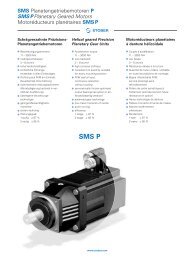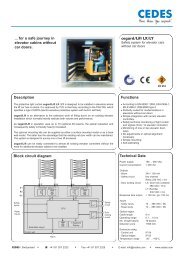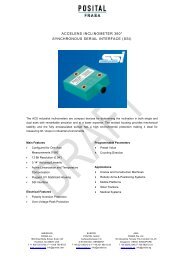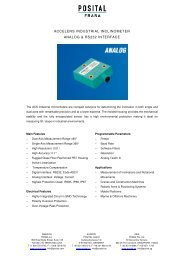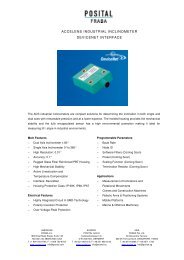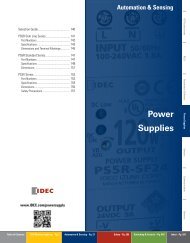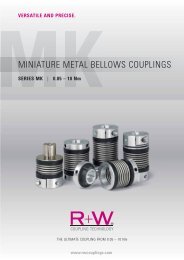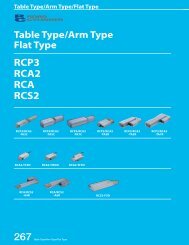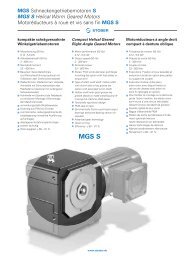RJ Series Slim Power Relays SJ Series Relay ... - REM-Technik sro
RJ Series Slim Power Relays SJ Series Relay ... - REM-Technik sro
RJ Series Slim Power Relays SJ Series Relay ... - REM-Technik sro
Create successful ePaper yourself
Turn your PDF publications into a flip-book with our unique Google optimized e-Paper software.
<strong>RJ</strong> <strong>Series</strong> <strong>Slim</strong> <strong>Power</strong> <strong><strong>Relay</strong>s</strong><br />
Instructions<br />
Driving Circuit for <strong><strong>Relay</strong>s</strong><br />
1. To make sure of correct relay operation, apply rated voltage to the<br />
relay coil.<br />
2. Input voltage for the DC coil:<br />
A complete DC voltage is best for the coil power to make sure of<br />
stable relay operation. When using a power supply containing a<br />
ripple voltage, suppress the ripple factor within 5%. When power<br />
is supplied through a rectification circuit, the relay operating characteristics,<br />
such as pickup voltage and dropout voltage, depend<br />
on the ripple factor. Connect a smoothing capacitor for better<br />
operating characteristics as shown below.<br />
Smoothing<br />
Capacitor<br />
+<br />
–<br />
R <strong>Relay</strong><br />
Pulsation<br />
Emin Emax Emean DC<br />
Emax – Emin<br />
Ripple Factor (%) × 100%<br />
Emean<br />
Emax = Maximum of pulsating current<br />
Emin = Minimum of pulsating current<br />
Emean = DC mean value<br />
3. Operating the relay in synchronism with AC load:<br />
If the relay operates in synchronism with the AC power voltage of<br />
the load, the relay life may be reduced. If this is the case, select a<br />
relay in consideration of the required reliability for the load. Or,<br />
make the relay turn on and off irrespective of the AC power phase<br />
or near the point where the AC phase crosses zero voltage.<br />
Vin<br />
R<br />
TE<br />
Load<br />
EAC<br />
4. Leakage current while relay is off:<br />
When driving an element at the same time as the relay operation,<br />
a special consideration is needed for the circuit design. As shown<br />
in the incorrect circuit below, leakage current (Io) flows through<br />
the relay coil while the relay is off. Leakage current causes the<br />
coil release failure or adversely affects the vibration resistance<br />
and shock resistance. Design a circuit as shown in the correct<br />
example.<br />
Incorrect<br />
R<br />
Io<br />
TE<br />
5. Surge suppression for transistor driving circuits:<br />
When the relay coil is turned off, a high-voltage pulse is generated,<br />
causing the transistor to deteriorate and sometimes to<br />
break. Be sure to connect a diode to suppress the counter electromotive<br />
force. Then, the coil release time becomes slightly<br />
longer. To shorten the coil release time, connect a Zener diode<br />
between the collector and emitter of the transistor. Select a Zener<br />
diode with a Zener voltage slightly higher than the power voltage.<br />
Protection for <strong>Relay</strong> Contacts<br />
1. The contact ratings show maximum values. Make sure that these<br />
values are not exceeded. When an inrush current flows through<br />
the load, the contact may become welded. If this is the case, connect<br />
a contact protection circuit, such as a current limiting resistor.<br />
2. Contact protection circuit:<br />
When switching an inductive load, arcing causes carbides to form<br />
on the contacts, resulting in an increased contact resistance. In<br />
consideration of contact reliability, contact life, and noise suppression,<br />
use of a surge absorbing circuit is recommended. Note that<br />
EAC<br />
Vin<br />
Correct<br />
Counter emf<br />
suppressing diode<br />
R<br />
+<br />
R <strong>Relay</strong><br />
–<br />
the release time of the load becomes slightly longer. Check the<br />
operation using the actual load. Incorrect use of a contact protection<br />
circuit will adversely affect switching characteristics. Four typical<br />
examples of contact protection circuits are shown in the<br />
following table:<br />
This protection circuit can be used when the<br />
load impedance is smaller than the RC impedance<br />
in an AC load power circuit.<br />
<strong>Power</strong><br />
Ind. Load<br />
R: Resistor of approximately the same resistance<br />
value as the load<br />
C R<br />
C: 0.1 to 1 µF<br />
RC<br />
Diode<br />
Varistor<br />
<strong>Power</strong><br />
+<br />
<strong>Power</strong><br />
–<br />
<strong>Power</strong><br />
C<br />
R<br />
This protection circuit can be used for both AC<br />
and DC load power circuits.<br />
R: Resistor of approximately the same resistance<br />
value as the load<br />
C: 0.1 to 1 µF<br />
This protection circuit can be used for DC load<br />
power circuits. Use a diode with the following<br />
ratings.<br />
Reverse withstand voltage:<br />
<strong>Power</strong> voltage of the load circuit × 10<br />
Forward current:<br />
More than the load current<br />
This protection circuit can be used for both AC<br />
and DC load power circuits.<br />
For a best result, when using on a power voltage<br />
of 24 to 48V AC/DC, connect a varistor across<br />
the load. When using on a power voltage of 100<br />
to 240V AC/DC, connect a varistor across the<br />
contacts.<br />
3. Do not use a contact protection circuit as shown below:<br />
C<br />
<strong>Power</strong><br />
C<br />
<strong>Power</strong><br />
Load<br />
Load<br />
D<br />
Varistor<br />
Ind. Load<br />
Ind. Load<br />
Ind. Load<br />
This protection circuit is very effective in arc suppression<br />
when opening the contacts. But, the capacitor is charged<br />
while the contacts are opened. When the contacts are<br />
closed, the capacitor is discharged through the contacts,<br />
increasing the possibility of contact welding.<br />
This protection circuit is very effective in arc suppression<br />
when opening the contacts. But, when the contacts are<br />
closed, a current flows to charge the capacitor, causing<br />
contact welding.<br />
Generally, switching a DC inductive load is more difficult than<br />
switching a DC resistive load. Using an appropriate arc suppressor,<br />
however, will improve the switching characteristics of a DC<br />
inductive load.<br />
Other Precautions<br />
1. General notice:<br />
To maintain the initial characteristics, do not drop the relay or<br />
shock the relay.<br />
The relay cover cannot be removed from the base during normal<br />
operation. To maintain the initial characteristics, do not remove<br />
the relay cover.<br />
Use the relay in environments free from condensation, dust, sulfur<br />
dioxide (SO 2 ), and hydrogen sulfide (H 2 S).<br />
Make sure that the coil voltage does not exceed the applicable<br />
coil voltage range.<br />
2. Connecting outputs to electronic circuits:<br />
When the output is connected to a load which responds very<br />
quickly, such as an electronic circuit, contact bouncing causes<br />
incorrect operation of the load. Take the following measures into<br />
consideration.<br />
• Connect an integral circuit.<br />
• Suppress the pulse voltage due to bouncing within the noise<br />
margin of the load.<br />
3. UL- and CSA-approved ratings may differ from product rated values<br />
determined by IDEC.<br />
4. Do not use relays in the vicinity of strong magnetic field, as this<br />
may affect relay operation.<br />
8





